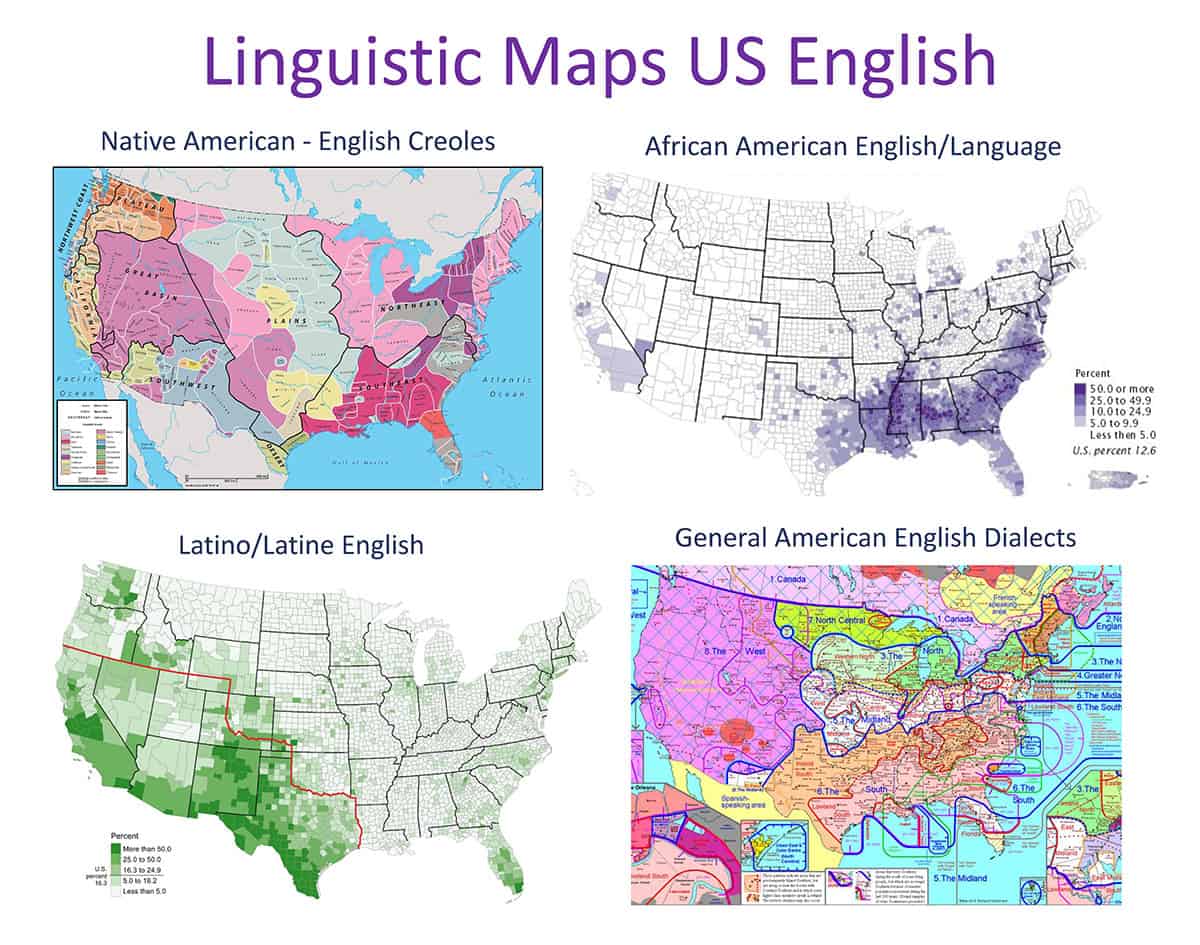Language Variation within US English
The extensive dialectal variation that exists within US English (represented by these maps) is a historical consequence of the social interaction between people as they migrated to (or were forcibly brought to) and then subsequently moved throughout what is today the US. Sociolinguists have investigated these differences for more than half a century (e.g., Labov, 1966) and for decades scholars have urged education educators to recognize and incorporate this knowledge of language differences into their classroom instruction (e.g. Smitherman, 1997; Wong Fillmore and Snow, 2000; Godley et al., 2006; Hudley & Mallinson, 2010; Hallet, 2015). In popular culture, Dr. Noma LeMoine (former Director of Los Angeles Unified School District’s Academic English Mastery Program) was interviewed about language variation in the 2005 PBS documentary Do You Speak American?

These and other seminal works inspired an enormous body of scholarship. A published 2013 bibliography included 1,624 references “… related to African American English (AAE), English-based pidgins and creoles, Latino English, Native American English, Caribbean English Creoles, and other English vernaculars, e.g. Appalachian English” (Rickford, Sweetland, Rickford, Grano, 2013). Extrapolating to today, an estimated 3,000 such works likely exist, authored by over 300 scholars from a wide range of academic fields including sociolinguistics, psycholinguistics, applied linguistics, anthropology, early literacy, English/language arts, sociology, history, and political science.
Despite this immense knowledge base, most practitioners are still unaware of US English as having multiple, linguistically legitimate dialectal varieties as opposed to one “correct” or “Standard” form. A recent published dissertation (based on data collected in NYC, one of America’s most linguistically diverse cities) reported that “the majority of teachers expressed that their teacher education program did not adequately train them to meet the linguistic needs of AAE speakers and 80% of teachers outlined instructional recommendations that aimed to ‘correct’ the use of AAE-features in writing assignments” (Hart, 2025). The correctionist approach is ineffective because it does not make linguistic sense. Students using vernacular English are not making errors in General American English (GAE); instead, they are speaking and/or writing correctly in their cultural linguistic system. In addition to confusing students, correctionism conveys dominant linguistic and cultural ideologies. In her landmark book (English with an Accent, 1997), Rosina Lippi-Green wrote: “Accent discrimination can be found everywhere in our daily lives.” Dr. Wayne O’Neil also described linguicism in a 1997 Rethinking Schools article as the last “legitimate” prejudice and as a “thinly veiled racism.”
How does the way we talk shape our social worlds? How do our social worlds shape the way we talk? In this session of Stanford Open Office Hours, Professor John Rickford responds to audience questions on the linguistics of race and ethnicity in America.
Bibliography
Cran, W., Buchanan, C., & MacNeil, R. (2005). Do you speak American? [Episode 3]. Films for the Humanities & Sciences.
Godley, A. J., Sweetland, J., Wheeler, R. S., Minnici, A., & Carpenter, B. D. (2006). Preparing teachers for dialectally diverse classrooms. Educational Researcher, 35(8), 30–37. https://doi.org/10.3102/0013189X035008030
Hallett, J. (2015). Contexts for student AAE use in the classroom. Critical Inquiry in Language Studies, 12(1), 1–26. https://doi.org/10.1080/15427587.2015.997648
Hart, M. (2025). Embracing language diversity: An exploration of elementary teachers’ perceptions of African American English [Doctoral dissertation, City University of New York]. CUNY Academic Works. https://academicworks.cuny.edu/gc_etds/6088
Hudley, A. C., & Mallinson, C. (2010). Understanding English language variation in U.S. schools. New York, NY: Teachers College Press.
Labov, W. (1966). The social stratification of English in New York City. Washington, DC: Center for Applied Linguistics.
Labov, W., Cohen, P., Robins, C., & Lewis, J. (1968). A study of the non-standard English of Negro and Puerto Rican speakers in New York City (Cooperative Research Project No. 3288). Philadelphia, PA: U.S. Regional Survey.
Lippi-Green, R. (1997). English with an accent: Language, ideology, and discrimination in the United States. London, England; New York, NY: Routledge.
O’Neil, W. (1997, Fall). If Ebonics isn’t a language, then tell me, what is? Rethinking Schools, 12(1), 10–11.
Rickford, J. R., Sweetland, J., Rickford, A. E., & Grano, T. (2013). African American, Creole, and other vernacular Englishes in education: A bibliographic resource. New York, NY; London, England: Routledge; Urbana, IL: National Council of Teachers of English.
Smitherman, G. (1977). Talkin and testifyin: The language of Black America. Detroit, MI: Wayne State University Press.
Wong Fillmore, L., & Snow, C. E. (2000). What teachers need to know about language. Washington, DC: Center for Applied Linguistics.